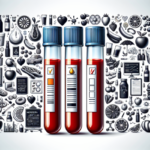Essential Insights into Blood Test Units for Enhanced Health Literacy
Developing a thorough comprehension of your health is fundamentally tied to your grasp of blood test units. These units act as the foundational tool through which healthcare professionals relay critical information regarding your body's physiological functions. Each test result, articulated in precise units, unveils the concentration of various elements present in your blood. This quantification is pivotal for ensuring accurate diagnoses, implementing effective treatments, and managing health holistically.
Understanding the Basics of Blood Test Units for Better Health Decisions

To truly value the importance of blood test units, one must comprehend their representation. Blood tests primarily assess quantities, determining levels of essential components like glucose, cholesterol, and electrolytes. The specific units employed may differ based on what is being measured, and they significantly influence whether a level is within a healthy range or indicates potential health issues. Understanding these aspects can empower individuals to engage more effectively with their health care.
Blood test units can typically be divided into two main categories: those measuring concentration (for instance, grams per litre or millimoles per litre) and those reflecting mass (such as milligrams per decilitre). For example, while glucose levels are usually reported in milligrams per deciliter (mg/dL) in the United States, other nations may opt for millimoles per litre (mmol/L). Grasping these distinctions is vital, as they can greatly affect the interpretation of test results and subsequent health decisions.
Additionally, these units facilitate standardization in health evaluations across different populations. By adhering to established units, healthcare providers ensure that results are communicated with accuracy and consistency, ultimately improving patient care and understanding of their health metrics.
Commonly Used Blood Test Units in Clinical Practice
Within the myriad of blood test units, certain units are more prevalent in clinical scenarios. The most frequently encountered include:
– Millimoles per litre (mmol/L): This unit is widely used for assessing glucose and cholesterol levels, especially in countries adhering to the metric system.
– Milligrams per decilitre (mg/dL): This unit is primarily utilized in the United States for evaluating glucose and cholesterol levels. Recognizing the differences between these two units is crucial for achieving accurate health evaluations and avoiding misunderstandings.
International Units (IU): This unit often measures vitamins and hormones, quantifying the biological effect of a substance rather than its mass, which is particularly useful for certain health assessments.
Each of these units carries distinct significance within the tests performed. For instance, a glucose level of 5.6 mmol/L signifies normal blood sugar levels, while the equivalent reading of 100 mg/dL could lead to different interpretations if unit conversions are not properly understood, highlighting the necessity for clarity in communication.
Essential Skills for Converting Blood Test Units Accurately
Acquiring the ability to convert between various blood test units is crucial knowledge for both patients and healthcare professionals alike. Mastery of these conversions can provide considerable clarity when interpreting test results and making informed health decisions.
To convert glucose levels from mmol/L to mg/dL, one generally multiplies the value by 18. Conversely, to translate from mg/dL to mmol/L, one divides the value by 18. For example, a glucose reading of 6 mmol/L equates to approximately 108 mg/dL. This understanding empowers patients to take a proactive stance in managing their health and recognizing when their levels require attention.
Many online calculators and conversion charts are available, simplifying the process for individuals looking to perform these conversions. Familiarizing oneself with these resources can enhance discussions with healthcare professionals, fostering informed and productive dialogues regarding health management and personal health strategies.
Critical Takeaways for Comprehending Blood Test Units

Grasping the concept of blood test units is vital for interpreting numerical data and gaining deeper insights into one’s health. These units play a significant role in diagnosing an array of health conditions and in the accurate analysis of results.
The Integral Function of Units in Diagnosing Health Conditions
The diagnostic process heavily depends on the precise measurement of substances present in the blood. Each blood test unit serves as a vital instrument that aids healthcare professionals in assessing health conditions. For instance, elevated levels of cholesterol, expressed in mg/dL, may signify a higher risk of heart disease, while abnormal glucose levels could indicate the presence of diabetes.
Healthcare providers utilize these units to establish reference ranges that define what is deemed ‘normal’ for healthy individuals. When test results fall outside these established ranges, it can signal underlying health issues warranting further investigation. Hence, understanding the units is essential; they not only reflect an individual’s current health status but also guide necessary interventions and treatment strategies.
Furthermore, a thorough understanding of these units promotes early disease detection, potentially leading to more favorable treatment outcomes. Therefore, patients are encouraged to familiarize themselves with the relevant units associated with their health assessments and the interpretation of blood test results.
Interpreting blood test units requires a nuanced perspective. Each test result should be examined within the broader context of the individual’s health history, presenting symptoms, and other pertinent factors. For example, a slightly elevated liver enzyme level may not be concerning by itself; however, if accompanied by additional symptoms, it could indicate a more severe condition necessitating further attention.
Additionally, variables such as age, gender, and lifestyle choices can significantly influence what is considered normal. Healthcare providers often take these factors into consideration when discussing results with patients, providing a comprehensive view of health rather than simply presenting numerical data.
Patients should feel empowered to ask questions regarding their results. Understanding what each unit signifies and how it correlates to overall health enables individuals to actively manage their health more effectively and make informed decisions regarding their wellness.
Emerging Developments in Blood Test Units You Should Know

The realm of blood test units is continuously advancing, with new trends emerging in standardization and technological progress. Recently, there has been a concerted movement towards adopting more universally recognized units to reduce confusion, particularly within global healthcare systems.
Moreover, technological innovations have paved the way for more sophisticated testing methods, resulting in increasingly accurate and reliable measurements. For instance, the development of point-of-care testing devices facilitates immediate feedback on blood test results, enabling faster decision-making in clinical environments.
These trends not only elevate the quality of patient care but also enhance patients' understanding of health metrics. As the healthcare landscape evolves, it is crucial for both patients and practitioners to stay informed about these developments and their implications for health management.
Applying Blood Test Units for Daily Health Management
Understanding blood test units extends beyond theoretical knowledge and holds significant practical implications for everyday health monitoring and management.
Leveraging Blood Test Units for Continuous Health Monitoring
Individuals can utilize blood test units for ongoing health tracking. Consistent testing can provide valuable insights into one’s health status, facilitating proactive management of conditions and lifestyle adjustments. For example, closely monitoring blood glucose levels is particularly beneficial for those at risk of developing diabetes.
Home testing kits are increasingly accessible, allowing individuals to conveniently monitor their levels. By comprehending the units associated with these tests, users can accurately interpret their results, enabling them to make necessary dietary or medication adjustments based on their readings and health objectives.
Furthermore, maintaining a health log to track these units over time can reveal essential trends, aiding users in identifying potential health issues before they escalate. This proactive involvement empowers individuals and enhances communication with healthcare providers, resulting in more tailored health strategies and interventions.
Blood Test Units: Informing Nutrition and Fitness Choices
Blood test units offer critical information for fitness enthusiasts and nutrition-focused individuals, which can guide dietary changes and training schedules. For instance, athletes frequently monitor their electrolyte levels, which can vary significantly during rigorous training sessions.
Understanding these units is crucial for optimizing performance. For example, runners may track their sodium levels to avert dehydration and ensure peak performance during competitions. Likewise, monitoring blood sugar levels can help in planning meal timing and composition, ultimately enhancing energy levels and recovery processes.
Nutritionists and trainers often leverage these metrics to create personalized fitness plans that align with an individual’s unique needs. By integrating blood test units into their fitness and nutrition strategies, individuals can achieve their health and performance goals more effectively and sustainably.
Blood Test Units: Essential for Managing Chronic Diseases
Blood test units are invaluable tools for individuals managing chronic conditions, such as diabetes or heart disease. Regularly monitoring key metrics allows for timely interventions and modifications to treatment plans. For example, patients with diabetes are required to consistently check their blood glucose levels to ensure they remain within optimal ranges.
Understanding the implications of units in these contexts empowers patients to take control of their health management. By recognizing when values are too high or too low, individuals can make informed decisions regarding necessary medication adjustments or dietary changes to maintain their health.
Healthcare providers can utilize this data to customize treatments, leading to improved patient outcomes. This proactive approach to health management underscores the necessity of familiarizing oneself with test units to effectively comprehend health results and make informed decisions.
Addressing Key Questions About Blood Test Units
As conversations surrounding blood test units continue to evolve, several inquiries arise that require clarification to enhance understanding.
What Do Blood Test Units Represent?
Distinct blood test units correspond to specific substances measured in the blood. For instance, glucose levels are often quantified in mg/dL or mmol/L, while cholesterol is generally reported in mg/dL. Understanding these units is essential for the accurate interpretation of health status and potential risks.
How Can I Interpret Blood Test Results Correctly?
Accurately reading blood test units requires familiarity with the reference ranges associated with each test. These ranges indicate what is typically considered normal. Patients should also consider their unique health profiles, as individual circumstances can significantly impact these interpretations.
Do Blood Test Units Differ by Country?
Yes, blood test units can vary significantly between countries. For example, while glucose levels are commonly reported in mg/dL in the United States, many other countries prefer using mmol/L. This variation emphasizes the importance of understanding the applicable units in your specific region and healthcare system.
Exploring Advanced Concepts of Blood Test Units
Diving into blood test units reveals a wealth of scientific principles and future possibilities that shape their utility.
The Scientific Foundations of Blood Test Units Explained
Understanding the scientific basis of blood test units entails examining the biochemical processes that dictate how substances are quantified in the blood. Each unit reflects distinct molecular weights and concentrations, which are critical for accurate testing and diagnosis.
Moreover, technological advancements in testing methodologies often stem from rigorous scientific inquiry, ensuring that results are both precise and applicable in clinical scenarios. This scientific foundation is essential for the ongoing refinement of testing protocols and practices.
Laboratory Standards Governing Blood Test Units for Accuracy
Laboratory standards are vital for ensuring the accuracy of blood test units. Regulatory agencies establish guidelines that laboratories must adhere to, ensuring tests are conducted consistently and results are reliable. These standards help minimize discrepancies that could lead to misdiagnosis or inappropriate treatments.
Furthermore, technological advancements have prompted laboratories to adopt more sophisticated methods, enhancing the precision of test results. Thus, staying informed about these standards is crucial for both healthcare professionals and patients to ensure high-quality care.
Future Innovations in Blood Test Units to Anticipate
Looking forward, exciting advancements in blood test units can be expected. Innovations in technology, such as the incorporation of artificial intelligence into diagnostic processes, may lead to more personalized and accurate testing. Additionally, standardizing units across different nations could simplify processes for individuals who travel or live abroad.
As research continues to evolve, the future of blood testing holds promise for enhanced health outcomes and broader access to quality healthcare services for all.
Real-Life Applications of Blood Test Units: Case Studies and Examples
Practical applications of blood test units offer valuable insights into their significance and utility in various health contexts.
Case Study: Effective Management of Blood Sugar Levels Through Knowledge
In a recent case study, a patient with type 2 diabetes demonstrated how a robust understanding of blood test units aids in managing blood sugar levels. By diligently monitoring their glucose levels in both mg/dL and mmol/L, the patient pinpointed patterns related to diet and exercise, yielding more effective management of their condition.
By consistently tracking these values and discussing them with their healthcare provider, the patient made informed decisions that led to improved health outcomes. This case underscores the importance of clarity in understanding blood test units for successful management of chronic diseases.
Real-Life Example: The Role of Blood Test Units During Pregnancy
Pregnant individuals frequently undergo a series of blood tests to monitor their health and that of their baby. A comprehensive understanding of blood test units is especially critical during this period, particularly for tests evaluating iron levels, glucose, and hormone levels.
For instance, a pregnant woman may be advised to maintain a specific hemoglobin level expressed in g/dL. Awareness of these units enables her to engage more effectively with her healthcare provider and make necessary lifestyle changes to support her health and that of her developing baby.
Case Study: Enhancing Athletic Performance via Blood Test Units
Athletes often utilize their knowledge of blood test units to improve their performance. A case study involving a professional cyclist highlighted the importance of monitoring lactate levels, typically represented in mmol/L. By understanding their lactate threshold, the athlete tailored their training regimen to optimize endurance and performance.
This case exemplifies how a solid grasp of blood test units can significantly benefit athletic performance, empowering athletes to make data-driven decisions regarding their training and recovery strategies.
Resources for Expanding Your Understanding of Blood Test Units
A variety of resources are available for individuals interested in deepening their knowledge of blood test units.
Recommended Literature for Blood Test Units
Numerous publications provide comprehensive insights into blood test units. Notable titles, such as “The Art of Blood Testing” and “Understanding Blood Tests: A Patient’s Guide,” offer valuable information on interpreting test results and their health implications.
Online Platforms for Blood Test Units Information and Resources
An extensive array of websites and tools can assist individuals in comprehending blood test units. Platforms like Lab Tests Online and the Mayo Clinic provide easily accessible information on various blood tests, elucidating their meanings and offering guidance on effective interpretation.
Educational Courses and Workshops on Blood Test Units
For those seeking deeper learning opportunities, many courses and workshops are dedicated to blood test units. Various healthcare institutions offer training programs covering the science of blood testing, result interpretation, and the latest advancements in laboratory standards and practices.
Commonly Asked Questions Regarding Blood Test Units
What Are Blood Test Units?
Blood test units are standardized measurements that quantify various components in the blood, providing critical information for diagnosing health conditions.
Why Do Different Units Exist?
Diverse units standardize measurements for specific substances, ensuring consistency and accuracy in health assessments across various regions and laboratories.
How Do I Convert Blood Test Units?
You can convert between blood test units using multiplication or division. For example, to convert glucose levels from mmol/L to mg/dL, multiply the value by 18.
Why Is Familiarity with Blood Test Units Important?
Understanding blood test units is essential for accurately interpreting health data, facilitating timely diagnoses, and guiding treatment decisions based on individual health needs.
Can Blood Test Units Evolve Over Time?
Yes, blood test units may change with advancements in medical standards, technology, and practices within the healthcare sector, reflecting ongoing improvements in health assessments.
Are At-Home Blood Tests Reliable?
At-home blood tests can be reliable; however, it is crucial to carefully adhere to the manufacturer’s instructions and consult healthcare professionals for interpreting results.
What Is the Role of Healthcare Providers in Blood Testing?
Healthcare providers play a crucial role in ordering tests, interpreting results, and advising patients on necessary lifestyle changes based on findings from blood tests.
How Often Should Blood Tests Be Conducted?
The frequency of blood tests is determined by individual health conditions, risk factors, and recommendations from healthcare professionals based on personal health assessments.
What Steps Should I Take If My Blood Test Results Are Abnormal?
If your blood test results are abnormal, consult your healthcare provider for evaluation and recommendations regarding treatment or further testing for your specific health situation.
Where Can I Find Additional Information About Blood Test Units?
You can broaden your understanding of blood test units through literature, online resources, and educational courses focused on health and laboratory testing practices.
Connect with us on Facebook for the latest updates!
This Article Was First Found On https://bloodtest.co.uk
The Article: Blood Test Units: Their Importance and Practical Applications appeared first on: https://ezbloodtest.com
The Article Blood Test Units: Importance and Practical Uses Explained Was Found On https://limitsofstrategy.com

